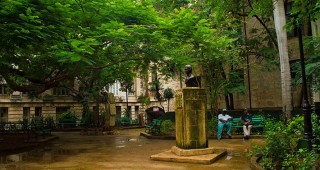Built in 1827, El Templete commemorates the first mass and town council held in the city, at the foot of a ceiba tree that grew on the northeast corner of what would soon evolve as the Plaza de Armas.
The structure imitates a small Greco-Roman temple, with Doric columns and classical pediment, although the pineapples that crown the pillars of the railings tropicalize the Neo-Classical severity. Construction was completed in 1828 in honor of Queen Josefa Amalia, wife of King Fernando VII. Its architecture represented the transition of the period, from the 19th-century ‘Cuban baroque’ to the Neoclassical style.
The small interior houses three large oil paintings by the French artist Jean Baptiste Vermay, a disciple of David and founder in 1818 of the San Alejandro Arts Academy in Havana. Vermay’s paintings depict the first mass, the first council, and the blessing of the Templete on its inauguration.
Every year, on November 16, the day on which Havana was founded, a procession of the city’s 16th-century maces – normally kept in the Museo de la Ciudad – makes its way around the Plaza de Armas to the ceiba to commemorate the city’s founding. Superstitious habaneros (and that means most everyone) queue up all evening to walk around the sacred ceiba tree three times and make a wish in the belief that the orishas will honor their wish.
Admission details: CUC 1 (incl. guide), free under-12s
























 Colonial
Colonial






